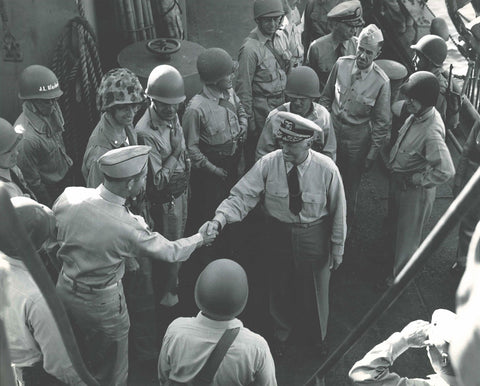
Book Review: ‘Nimitz at War’ by Craig L. Symonds
nimitz at war
Command Leadership from Pearl Harbor to Tokyo Bay
By Craig L. Symonds. 474 pp. Oxford University Press, 2022. $29.95.
American theater commanders in World War II included Admiral Chester Nimitz and Generals Dwight D. Eisenhower, Douglas MacArthur and Joseph Stilwell. Among them Nimitz stands out, for he alone won great battles like Midway while outnumbered and Guadalcanal while merely at parity. And unlike his peers, Nimitz made but one serious error — when he permitted the costly 1944 attack on Peleliu to proceed despite Admiral William F. Halsey’s urging to cancel the operation.
"Nimitz at War," the first major biography of the U.S. Pacific Fleet commander published in nearly 50 years, represents not just a stellar achievement for author Craig Symonds but also closes an elegant circle. (Here I must disclose that I am a friend of Symonds and reviewed his original manuscript.) Late U.S. Naval Academy professor E. B. Potter, who produced his own excellent Nimitz biography in 1976, served as Symonds’s colleague and mentor when the latter, now a professor emeritus, began his career as a historian at the Naval Academy. In the following decades, fresh archival documentation on Nimitz’s performance has come to the forefront, notably code-breaking material far beyond the disclosures that Potter had accessed about the Battle of Midway and vital documents previously unavailable to Potter that unveiled code-breaking's pervasive influence on American operations. This includes the single-most important document on naval operations in the Pacific, known as the “Graybook” (after its original cover) — effectively Nimitz’s war diary. Access to these records alone soars "Nimitz at War" to first-rank importance.
GET HISTORY 'S GREATEST TALES—RIGHT IN YOUR INBOX
Subscribe to our Historynet Now! newsletter for the best of the past, delivered every Wednesday.
Close
Thank you for subscribing!
Submit
But Symonds also took the bold path of confining his account to Nimitz’s most important career role as commander-in-chief of the Pacific Fleet and Pacific Ocean areas between 1941 and 1945. (Readers looking to learn more about Nimitz’s life in its entirety can reference Potter.) This concentrated focus illuminates Nimitz’s wartime performance at multiple levels.
After taking command in December 1941, Nimitz displayed acute judgment and moral courage during his extremely stressful shakedown cruise, completed in the buildup to June 1942’s Battle of Midway. He faced daunting odds against the formidable Japanese Imperial Navy while his boss, Admiral Ernest J. King, bluntly dismissed him as a paper-pushing personnel specialist unfit for his command. Then there is the Nimitz that’s an adroit manager of people, marked by his handling of his doubtful superior, King; his egocentric Pacific Theater rival, General MacArthur; and his temperamentally opposite fleet commanders, the cerebral and deliberate Raymond A. Spruance and the mercurial and hyper- aggressive Halsey. Nimitz’s sound — and often daring — vision in strategy (for example, rejecting advice from major subordinates to attack the inner Marshall Islands, not the well-defended outer islands), as well as his forceful leadership, also propelled his sailors to adopt challenging new technology, like radar, and operational methods, such as the Combat Information Center — an invaluable new tactical facility Nimitz pushed on every major warship.
But the transcendent quality Nimitz exhibited to secure his stature as one of America’s greatest admirals is character: in this instance, defined as always doing what he deemed to be right regardless of immediate or long-term personal interests. This is the timeless message conveyed throughout a powerfully compelling narrative.
— Richard B. Frank’s most recent work is Tower of Skulls (2020), the first volume of a trilogy on the Asia-Pacific War
